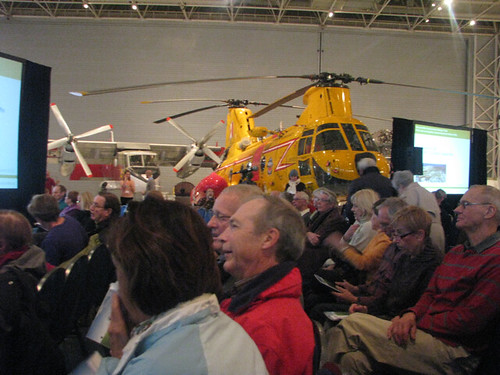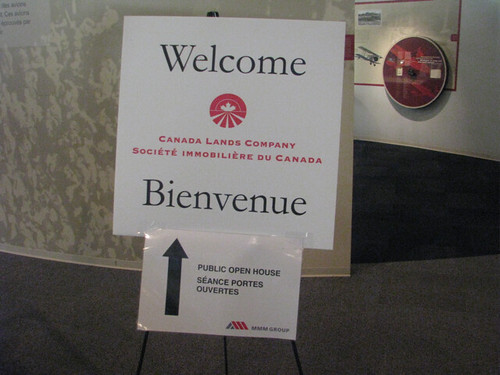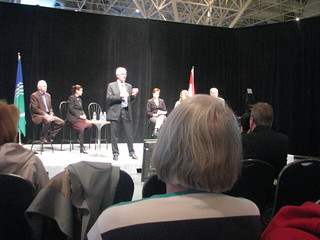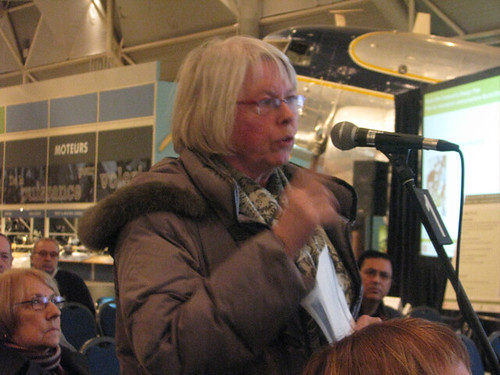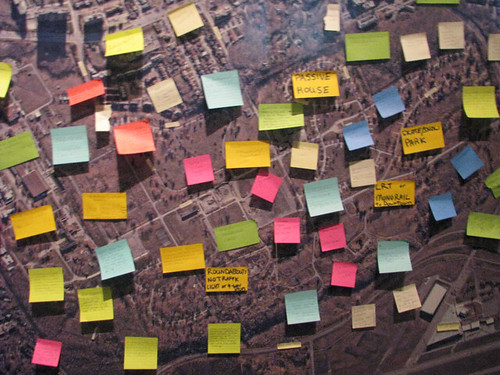Building a new neighbourhood from scratch can be the work of at least a decade these days.
From the initial proposal to change a property’s zoning from whatever it was to the sort of mixture deemed most useful at the time to the final piece of work in the last house or strip mall to be built, dozens of companies, hundreds or thousands of workers providing all manner of services: from legal advice to portable toilets; from heavy machinery to internet support. Small wonder, then, that the work to reinvent the former CFB Rockcliffe from military base into Ottawa’s newest neighbourhood is expected to take nearly two decades. This, after a five-year delay owing to the need to settle a land claim with the Algonquins of Ontario, now settled sufficiently to their satisfaction.
On November 26th, the Canada Lands Company held an “Ideas Fair” at the Canadian Aviation and Space Museum. The goal was to open up the discussion between the crown corporation, the city government, and the Ottawa public at large on how to best rebuild the former airbase into a livable region of the city.
Based on what this observer saw that night, the communities of Ottawa represented from communities as close by as Manor Park and from as far as Orléans certainly stepped forward to make their various views and hopes known. If the attendees weren’t expecting to personally live in whatever the CFB Rockcliffe grounds become, they could be expected to know someone who harbours such hopes for their own future.
As for Canada Lands Company and its assorted partners as represented by Don Schultz and Manon Lapensée – among several others – they weren’t holding back either in explaining what they hope to achieve: a community that takes its place among the neighbourhoods of Ottawa, residency numbers expected to be from ten to sixteen thousand. A neighbourhood designed to achieve LEED certification for both the development as a whole and for an as yet undetermined number of specific projects scattered through the area. Ambition was not in short supply that night, nor was expertise and good intent.
That’s as it should be for a project of this size and scope.
Take for instance the attention paid by landscape architect Janet Rosenberg to the idea and application of existing landscapes and foliage as part of a neighbourhood’s infrastructure. Rosenberg spoke of this in terms of “green” and “blue” infrastructure, referring to plant life and water respectively, with each category of natural components having its own set of governing principles. On the “green” side: Protect, Connect, Gather and Transition. On the “blue”: Maintain, Create and Harvest.
For additional details, a look at the presentation material archived at CLC’s Rockcliffe project website is strongly recommended.
Among the many in attendance – CLC estimated aboput 600 – was Ottawa city councilor Marianne Wilkinson, with some advice on getting the project’s ducks lined up properly in anticipation of future changes to Ottawa’s transportation and transit planning.
Those transit concerns also got a fair amount of air time from attendees in general, particularly in light of decisions reached by City Hall regarding the LRT plan in the five years since the Rockcliffe project went on hold. With the next phase of LRT being routed to Blair Station via the Transitway rather than via Montréal Road – which would be more directly to the south of the redevelopment project – plans for feeding and being fed by the Transitway network will have to change accordingly. Some discussion of the possibility of a streetcar line through the new neighbourhood also came up, and that will also be followed up in the months ahead one way or another.
And whatever happens with transit, there’s no guarantee that the existing street network will be kept completely intact. But given that the old alignments were designed to serve a military base rather than a mixed-use civilian neighbourhood, that may not be considered a problem.
The organizers had no shortage of ways of getting their feedback on the project. A video option was available for those willing to use it. Written survey forms, of course, have long been standard operating procedure. The visual that stays in the mind, though, is the “Idea Cloud”: a blown-up reproduction of satellite photography of the neighbourhood to which people stuck Post-It style notes, hand-written with personal suggestions.
There will be follow-up of some kind. CLC has already scheduled the next public consult for the spring of 2013…


